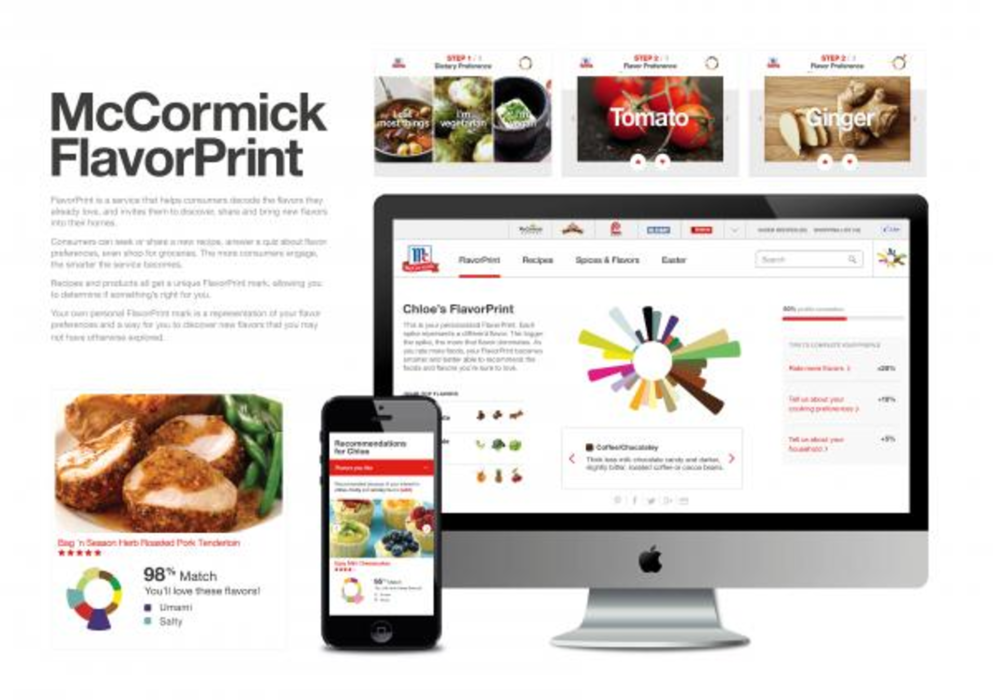McCormick’s FlavorPrint has helped improve the spice company’s customer engagement and sales.
A brand is defined by the interactions customers have with it—not by how the company defines it, asserts Carlton Doty, VP and group director at Forrester Research Inc. “Their experiences will determine whether they come back and interact with you again,” Doty said during his presentation at Salesforce.com’s ExactTarget Connections conference.
One powerful way to improve the customer experience: understand customer context. “Context is the marketer’s new remit,” Doty said. “I challenge you to find any marketers who’s not data-driven. But context is a different kind of data. Context is information that can be collected from all kinds of sources—but not from CRM. It’s collected in real time.” And, then used in real time “in that moment of a customer’s time of need,” he said.
Marketing before context Marketing after context
FROM TO
Campaigns Interactions
Targeting an audience Engaging them one-on-one
Customer segmentation Customer recognition
Media schedules Customer moments
Message/communication Utility/value
Transactions Value exchanges
GPRs/CMPs Minutes of engagement
Recognizing customers, Doty said, is not about their ID; it’s about who they are, what they’ve done with you in the past, and what they’re doing in the moment. Additionally, he explained, customer interactions aren’t always about revenue in the moment. In some cases those interactions should be about a value exchange. “That’s what keeps customers coming back and leads to more transactions,” he said, adding that it’s essential for marketers to understand why customers are interacting with their company. Is it for service? Sales? That contextual understanding allows for a more appropriate and relevant interaction.
According to Doty, traditional marketing campaigns no longer cut it. “They’re not dead, but marketing can’t be just [a series of disconnected campaigns] anymore,” he said. Why? Fewer than 25% of consumers trust offline ads, and less than 20% trust online ads, Doty pointed out. Even so, 62% of marketers will grow digital marketing over the next year, he said.
Virtuous cycle
Doty recommended taking a new approach; one that allows for reacting to customer context. “Today’s campaigns are linear: strategy, planning, analytics, design, execution; then marketers track campaign performance,” he said. “But I believe marketing will shift to an agile, iterative approach to reaching customers. The customer lifecycle today is non-linear. The funnel is dead. Very few customers go through a linear path-to-purchase. It’s more of a circle.” The elements of that circle are discover, explore, buy, use, ask, and engage.
Understanding customer context helps marketers to react more appropriately to where customers are in that path-to-purchase. It also helps to create a virtuous cycle of learning, acting, and reacting. “Contextual interactions perpetuate a value exchange,” Doty said.
Doty explained by way of example that the real value of the business model of Fitbit and other wearable devices is the contextual data. But the benefits aren’t just for tech-related companies. Doty cited as another example spice company McCormick & Co., which “never had a relationship with end consumers in its century-long existence.” According to Doty, McCormick’s CIO partnered with one of the company’s digital experts to figure out how to digitally engage with its consumers. The result was FlavorPrint. Consumers who use it are asked questions about meals and in response give thumbs up or down; additionally, they answer questions on what ingredients they have at home and how they like food prepared. Then the system gives each user a personal flavor print. But it doesn’t end there. Now, every time McCormick reaches out to a customer who’s used FlavorPrint, the communication includes that FlavorPrint, along with a recipe recommendation, and related information. As a result, McCormick has seen a 9X increase in website visits, as well as sales increases among participants.
Getting contextual
Using customer context is an approach any marketing organization can adopt, Doty asserted. So, how can marketers use customer context?
Not surprisingly, the first step is to define your strategy, he said. “Determine the soul and purpose of your brand and what it stands for or nothing else will matter,” Doty said. That will help to identify unique interactions that support that purpose.
Next is to reorganize your processes to be more iterative. Additionally, he said, use content to provide utility to customers.
In terms of technology, Doty recommended that marketers adapt their marketing-tech portfolio: Take an inventory of what they have, then identify what they need to invest in. This includes mapping technology assets to customers’ journeys; i.e., how technology touches customers. Of course, if there’s not a customer journey map in place, it’s important to create one.
Forrester defines the technology primarily needed for contextual marketing as follows: “A contextual marketing engine is a brand-specific platform that exploits customer context to deliver utility and guide the customer into the next best interaction.” A contextual marketing engine will help to bridge the gap between marketing and customer experience, drive more useful interactions, and provide a persistent incentive to engage, Doty said. Customers will come back because they have a reason to,” he said. “It redefines the purpose of your campaigns; it aims to spark interactions across the customer lifecycle.”
Remember, too, that contextual marketing is about using customer data. So, Doty advised accelerating innovation with analytics. “Use big data technology to get predictive; compress the data-to-insight process,” he said. “Don’t create reports that gather dust; focus on usable data.”
Finally, be sure to team up marketers, data scientists, and technologists to ensure success.
“Who owns the customer?” Doty asked. “No one. But somebody always owns the moment.”








